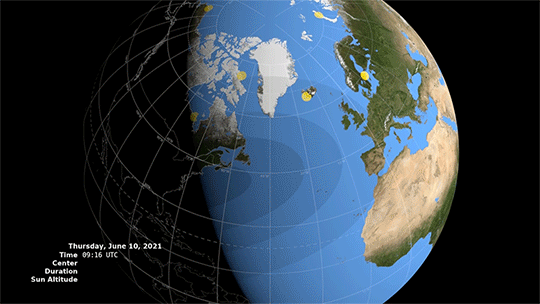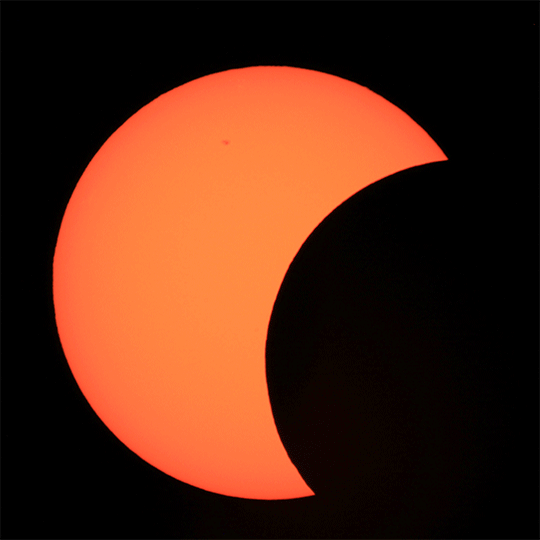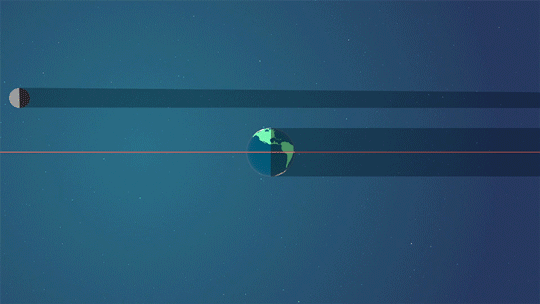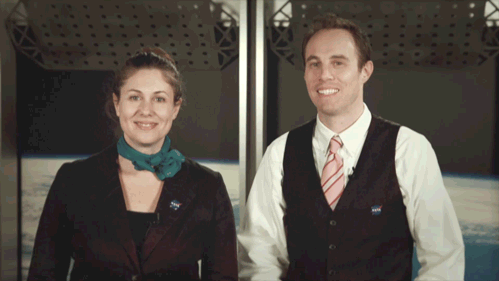On June 10, people in parts of the northern hemisphere will have the chance to witness a solar eclipse.

Watch the full visualization of the eclipse.
The June 10 eclipse is an annular solar eclipse, meaning that the Sun will never be completely covered by the Moon. The Moon’s orbit around the Earth is not a perfect circle, so throughout each month, the Moon’s distance from Earth varies. During an annular eclipse, the Moon is far enough away from Earth that the Moon appears smaller than the Sun in the sky. Since the Moon does not block the entire view of the Sun, it will look like a dark disk on top of a larger, bright disk. This creates what looks like a ring of fire around the Moon.
People in the narrow path of annularity — which, for this eclipse, cuts through Canada, Greenland, and northern Russia — will see the ring of fire effect as the Moon passes across the Sun.

Credit: Dale Cruikshank
Outside this path of annularity, many people in the northern hemisphere have a chance to see a partial solar eclipse. The partial eclipse will fall on parts of the eastern United States, as well as northern Alaska. Some locations will only see a very small piece of the Sun covered, while locations closer to the path of annularity can see the Moon cover most of the Sun.
To learn which times the eclipse may be visible in certain areas, you can click anywhere on the map here. (Note that the maximum obscuration and maximum eclipse timing noted on this map may occur before sunrise in many locations.)

This solar eclipse is a pair with the total lunar eclipse that happened on May 26.
Both solar and lunar eclipses happen when the Sun, Moon, and Earth line up in the same plane — a lunar eclipse happens when Earth is in the middle and casts its shadow on the Moon, and a solar eclipse happens when the Moon is in the middle and casts its shadow on Earth. The Moon’s orbit is tilted, so it’s usually too high or too low for this alignment to work out.

The May 26 lunar eclipse was a supermoon lunar eclipse, meaning that the full moon happened while the Moon was near its closest point to Earth, making the Moon appear larger in the sky. The solar eclipse happens at the opposite point of the Moon’s orbit, during the new moon — and in this case, the new moon happens near the Moon’s farthest point from Earth, making the Moon appear smaller and resulting in an annular (rather than total) solar eclipse.
From anywhere: Watch the eclipse online with us! Weather permitting, we’ll be sharing live telescope views of the partial eclipse courtesy of Luc Boulard of the Royal Astronomical Society of Canada Sudbury Centre. Tune in starting at 5 a.m. EDT on June 10 at nasa.gov/live.
From the path of the annular or partial eclipse: Be sure to take safety precuations if you plan to watch in person!
It is never safe to look directly at the Sun’s rays, even if the Sun is partly or mostly obscured, like during a partial or annular eclipse — doing so can severely harm your eyes. If you’re planning to watch the eclipse on June 10, you should use solar viewing glasses or an indirect viewing method at all points during the eclipse if you want to face the Sun. Solar viewing glasses, sometimes called eclipse glasses, are NOT regular sunglasses; regular sunglasses are not safe for viewing the Sun.

If you don’t have solar viewing or eclipse glasses, you can use an alternate indirect method like a pinhole projector. Pinhole projectors shouldn’t be used to look at the Sun; instead, they’re an easy way to project an image of the Sun onto a surface. Read more about how to create a pinhole projector.
This is a sunrise eclipse in the contiguous U.S. At locations in the lower 48 states that can see the partial eclipse, the show starts before sunrise, when the Sun is still below the horizon. That means the best chance to see the eclipse in these locations will be during and shortly after sunrise, when the Sun is very low in the sky. In northern Alaska, the eclipse happens in the very early hours of June 10 when the Sun is low on the horizon.
Bottom line: If you’re trying to watch the eclipse in the contiguous U.S., look for a location with a clear view of the horizon to the northeast, and plan to watch starting at sunrise with your solar filter or indirect viewer.
The next two eclipses in the continental U.S. are in 2023 and 2024. The annular solar eclipse of Oct. 14, 2023, will cut from Oregon to Texas, and the total solar eclipse of April 8, 2024, will pass from Texas to Maine. Keep up with the latest on eclipses and eclipse science at nasa.gov/eclipse.
Make sure to follow us on Tumblr for your regular dose of space: http://nasa.tumblr.com.
source: nasa.tumblr.com